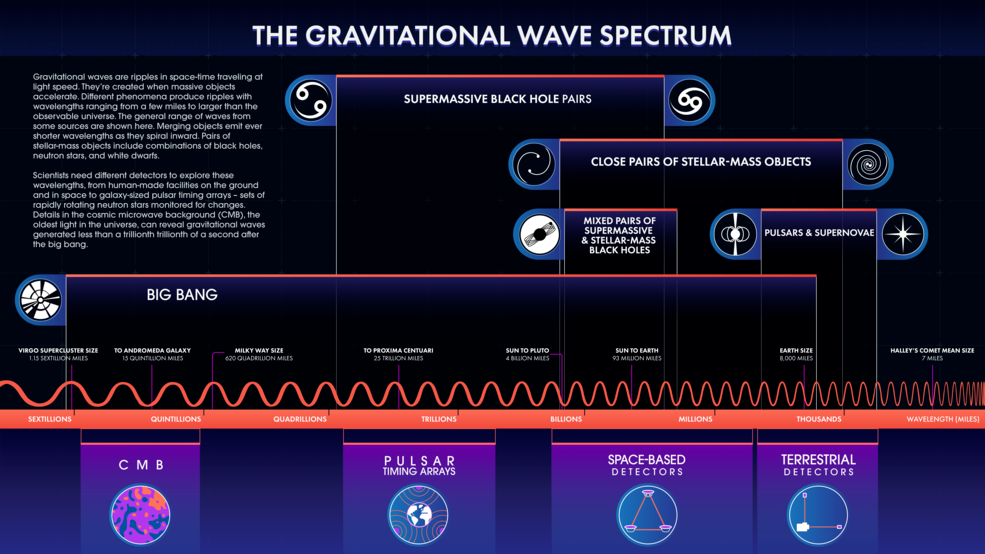Reviewed by Alex SmithApr 8 2022
Gravitational waves are a chaotic sea of ripples in space-time that make up the universe. Astronomers have been hoping to witness waves from circling pairs of supermassive black holes in faraway galaxies for years, and now they are one step closer thanks to NASA’s Fermi Gamma-ray Space Telescope.
 The length of a gravitational wave, or ripple in space-time, depends on its source, as shown in this infographic. Scientists need different kinds of detectors to study as much of the spectrum as possible. Image Credit: NASA’s Goddard Space Flight Center Conceptual Image Lab.
The length of a gravitational wave, or ripple in space-time, depends on its source, as shown in this infographic. Scientists need different kinds of detectors to study as much of the spectrum as possible. Image Credit: NASA’s Goddard Space Flight Center Conceptual Image Lab.
Fermi identifies the type of light with the highest energy; gamma rays. For over a decade, an international team of scientists has examined Fermi data collected from pulsars, the rapidly revolving cores of stars that erupted as supernovae.
They were looking for small differences in the arrival timing of gamma rays from these pulsars, which could have been created by light traveling through gravitational waves on its route to Earth. However, they were unable to locate any.
While no waves were observed, the research indicates that these waves may be within Fermi’s reach with more observations.
We kind of surprised ourselves when we discovered Fermi could help us hunt for long gravitational waves. It’s new to the fray – radio studies have been doing similar searches for years. But Fermi and gamma rays have some special characteristics that together make them a very powerful tool in this investigation.
Matthew Kerr, Research Physicist, U.S. Naval Research Laboratory
Kerr and Aditya Parthasarathy, a scientist at the Max Planck Institute for Radio Astronomy in Bonn, Germany, co-led the study, which was published online on April 7th, 2022, in the journal Science.
Gravitational waves travel at the speed of light when big objects accelerate. The ground-based Laser Interferometer Gravity Wave Observatory, which identified gravitational waves for the first time in 2015, can observe ripples tens to hundreds of miles long from crest to crest that pass by Earth in fractions of a second.
The Laser Interferometer Space Antenna, which will be launched into space in the near future, will detect waves that are millions to billions of kilometers long.
Kerr and his team are looking for light-year-long waves that travel billions of kilometers and take years to reach the Earth. The gravitational wave background, a random sea of waves that are formed in part by pairs of supermassive black holes in the nuclei of merging galaxies across the universe, is responsible for these extended ripples.
Pulsar timing arrays, which are galaxy-sized detectors, are needed to find them. These arrays rely on millisecond pulsars, which spin as quickly as blender blades. Millisecond pulsars sweep radio and gamma-ray beams past our line of sight, seeming to pulse with remarkable regularity—like cosmic clocks.
Long gravitational waves lag or advance the arrival time of light by billionths of a second when they pass between one of such pulsars and Earth. Scientists believe that by scanning for a precise pattern of pulse changes among pulsars in an arrangement, they will be able to detect gravity waves passing by.
Pulsar timing arrays have been used by radio astronomers for decades, and their measurements are the most susceptible to gravitational waves. However, interstellar impacts make radio data analysis more difficult. The universe is littered with wayward electrons. Their combined actions distort the path of radio waves across light-years.
The arrival times of pulses at different frequencies change as a result of this. These problems are not present with gamma rays, which serve as a supplemental probe as well as an independent validation of the radio results.
The Fermi results are already 30% as good as the radio pulsar timing arrays when it comes to potentially detecting the gravitational wave background. With another five years of pulsar data collection and analysis, it’ll be equally capable with the added bonus of not having to worry about all those stray electrons.
Aditya Parthasarathy, Scientist, Max Planck Institute
Radio and gamma-ray astronomers strive to reach sensitivities that will enable them to detect gravitational waves from circling pairs of giant black holes within the next decade.
“Fermi’s unprecedented ability to precisely time the arrival of gamma rays and its wide field of view make this measurement possible,” said Judith Racusin, Fermi deputy project scientist at NASA’s Goddard Space Flight Center in Greenbelt, Maryland.
“Since it launched, the mission has consistently surprised us with new information about the gamma-ray sky. We’re all looking forward to the next amazing discovery,” Racusin added.
Goddard manages the Fermi Gamma-ray Space Telescope, an astrophysics and particle physics collaboration. Fermi was created in partnership with the US Department of Energy, with significant input from academic institutions and collaborators in France, Germany, Italy, Japan, Sweden and the US.
Journal Reference:
Ajello, M., et al. (2022) A gamma-ray pulsar timing array constrains the nanohertz gravitational wave background. Science. doi.org/10.1126/science.abm3231.